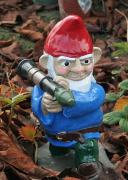
Originally Posted by
LSP972

That's what Herb Belin claimed, when the MIM parts first began wide-spread integration into their revolvers and pistols.
What they (S&W) DON'T tell you is the decision to use MIM was reached after a lot of soul-searching and number crunching. Their work force was approaching a sea change; most all of the long-time, highly experienced machinists, tool makers, and fitters were looking at retirement. S&W had the choice of hiring, training, and paying (at ruinous rates; while never a "union shop", the new breed of folks were demanding union pay scales) a lot of new employees. The move to MIM reduced the need for many of these folks (except fitters), so it made for a better bottom line.
I have been told that the main advantage of MIM parts is that they are through-hardened. The old forged, case-hardened parts you had to be damned careful with; break through that case hardening with file or stone, and the part was ruined. A part that is the same hardness all the way through would definitely make whittling on trigger/hammer steps a bit less daunting, for sure.
.



 Reply With Quote
Reply With Quote

